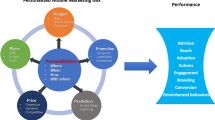Abstract
Since the first release of Apple iPad in April 2010, tablet computers (or simply tablets) can be viewed as a new category of technological products for general consumers. To compete in the evolving market, it is expected that the manufacturers need to customize the design of tablets to satisfy different needs of customers. To support product customization in this context, one specific challenge is that the customer information of tablets is relatively limited due to the newness of the product category. To tackle this challenge, this paper proposes a data mining approach to analyze the online reviews that contain customer opinions towards tablet products. In this research, tablet usages are first classified according to three user types: personal, business and student. From the online reviews, association rule mining is applied to investigate what tablet attributes are desired by specific user types. To examine the approach, the online reviews were collected from the time between April 2010 (first release of Apple iPad) and May 2011. Then, the association rule results from that time are compared with the recent tablet products on the market. It is demonstrated that online reviews as the original customer information can provide relevant insights for product customization.


Similar content being viewed by others
References
Aciar, S., Zhang, D., Simoff, S., & Debenham, J. (2007). Informed recommender: Basing recommendations on consumer product review. IEEE Intelligent Systems, 22, 39–47.
Agard, B., & Kusiak, A. (2004). Data-mining-based methodology for the design of product families. International Journal of Production Research, 42, 2955–2969.
Agrawal, R., & Srikant, R. (1994). Fast algorithms for mining association rules in large databases. In Proceedings of the 20th international conference on very large data bases (pp. 487–499). San Francisco, USA.
Aral, S., & Walker, D. (2011). Creating social contagion through viral product design: A randomized trial of peer influence in networks. Management Science, 57, 1623–1639.
Archak, N., Ghose, A., & Ipeirotis, P. G. (2011). Deriving the pricing power of product features by mining consumer reviews. Management Science, 57, 1485–1509.
Braha, D. (Ed.). (2001). Data mining for design and manufacturing: Methods and applications. Dordrecht: Kluwer.
Brown, R. (1992). Managing the ‘S’ curves of innovation. Journal of Consumer Marketing, 9, 61–72.
Cardie, C. (1997). Empirical methods in information extraction. AI Magazine, 18, 65–79.
Chen, Y., & Xie, J. (2008). Online consumer review: Word-of-mouth as a new element of marketing communication mix. Management Science, 54, 477–491.
Chevalier, J. A., & Mayzlin, D. (2006). The effect of word of mouth on sales: Online book reviews. Journal of Marketing Research, 43, 345–354.
Choudhary, A. K., Harding, J. A., & Tiwari, M. K. (2009). Data mining in manufacturing: A review based on the kind of knowledge. Journal of Intelligent Manufacturing, 20, 501–521.
Cunningham, H., Maynard, D., Bontcheva, K., & Tablan, V. (2002). GATE: An architecture for development of robust HLT application. In Proceedings of the 40th annual meeting of the association for computational linguistics (ACL’02) (pp. 168–175). Philadelphia.
Du, X., Jiao, J., & Tseng, M. M. (2006). Understanding customer satisfaction in product customization. International Journal of Advanced Manufacturing Technology, 31, 396–406.
Duan, W., Gu, B., & Whinston, A. B. (2008). The dynamics of online word-of-mouth and product sales: An empirical investigation of the movie industry. Journal of Retailing, 84, 233–242.
Franke, N., Schreier, M., & Kaiser, U. (2010). The ‘I Designed It Myself’ effect in mass customization. Management Science, 56, 125–140.
Gilmore, J. H., & Pine, B. J, I. I. (1997). The four faces of mass customization. Harvard Business Review, 75, 91–101.
Gunasekaran, A. (1999). Agile manufacturing: A framework for research and development. International Journal of Production Economics, 62, 87–105.
Hamm, S. (2009). The race for perfect: Inside the quest to design the ultimate portable computer. New York: McGraw-Hill.
Han, J., & Kamber, M. (2006). Data mining: Concepts and techniques (2nd ed.). San Francisco: Morgan Kaufmann.
Harding, J. A., Shahbaz, M., Srinivas, S., & Kusiak, A. (2006). Data mining in manufacturing: A review. Journal of Manufacturing Science and Engineering, 128, 969–976.
Hong, G., Hu, L., Xue, D., Tu, Y. L., & Xiong, Y. L. (2008). Identification of the optimal product configuration and parameters based on individual customer requirements on performance and costs in one-of-a-kind production. International Journal of Production Research, 46, 3297–3326.
Hong, G., Dean, P., Yang, W., Tu, Y. L., & Xue, D. (2010). Optimal concurrent product design and process planning based on the requirements of individual customers in one-of-a-kind production. International Journal of Production Research, 48, 6341–6366.
Jackson, P., & Moulinier, I. (2002). Natural language processing for online applications: Text retrieval, extraction and categorization. Philadelphia: John Benjamins Publishing.
Jiao, J., & Tseng, M. M. (1999). A methodology of developing product family architecture for mass customization. Journal of Intelligent Manufacturing, 10, 3–20.
Jiao, J., & Zhang, Y. (2005). Product portfolio identification based on association rule mining. Computer-Aided Design, 37, 149–172.
Jin, Y., & Ishino, Y. (2006). DAKA: Design activity knowledge acquisition through data-mining. International Journal of Production Research, 44, 2813–2837.
Kuo, T. C. (2012). Mass customization and personalization software development: A case study eco-design product service system. Journal of Intelligent Manufacturing. doi:10.1007/s10845-012-0643-8.
Liu, C., Ramirez-Serrano, A., & Yin, G. (2012). An optimum design selection approach for product customization development. Journal of Intelligent Manufacturing, 23, 1433–1443.
Mavridou, E., Kehagias, D. D., Tzovaras, D., & Hassapis, G. (2011). Mining affective needs of automotive industry customers for building a mass-customization recommender System. Journal of Intelligent Manufacturing. doi:10.1007/s10845-011-0579-4.
Michalek, J. J., Ceryan, O., Papalambros, P. Y., & Koren, Y. (2006). Balancing marketing and manufacturing objectives in product line design. Journal of Mechanical Design, 128, 1196–1204.
Moon, S. K., Simpson, T. W., & Kumara, S. R. T. (2010). A methodology for knowledge discovery to support product family design. Annals of Operations Research, 174, 201–218.
Mostafa, M.M. (2013). More than words: Social networks’ texting mining for consumer brand sentiments. Expert Systems with Applications, Article in Press, doi:10.1016/j.eswa.2013.01.019
Pang, B., & Lee, L. (2008). Opinion mining and sentiment analysis. Information Retrieval, 2, 1–135.
Pine, B. J, I. I. (1993). Mass customization: The new frontier in business competition. Boston: Harvard Business School Press.
Porter, M. E. (1985). Competitive advantage: Creating and sustaining superior performance. New York: The Free Press.
Risdiyono & Koomsap, P. , (2011). Design by customer: Concept and application. Journal of Intelligent Manufacturing. doi:10.1007/s10845-011-0587-4.
Romanowski, C. J., & Nagi, R. (2004). A data mining approach to forming generic bills of materials in support of variant design activities. Journal of Computing and Information Science in Engineering, 4, 316–328.
Salvador, F., de Holan, P. M., & Piller, F. (2009). Cracking the code of mass customization. MIT Sloan Management Review, 50, 71–78.
Shahbaz, M., Srinivas, S., Harding, J. A., & Turner, M. (2006). Product design and manufacturing process improvement using association rules. Journal of Engineering Manufacture (Part B), 220, 243–254.
Shao, X., Wang, Z., Li, P., & Feng, C. J. (2006). Integrating data mining and rough set for customer group-based discovery of product configuration rules. International Journal of Production Research, 44, 2789–2811.
Siddiqui, T., & Tiwary, U. S. (2008). Natural language processing and information retrieval. Oxford: Oxford University Press.
Silveira, G. D., Borenstein, D., & Fogliatto, F. S. (2001). Mass customization: Literature review and research directions. International Journal of Production Economics, 72, 1–13.
Song, Z., & Kusiak, A. (2009). Optimizing product configurations with a data-mining approach. International Journal of Production Research, 47, 1733–1751.
Tapscott, D., & Williams, A. D. (2006). Wikinomics: How mass collaboration changes everything. New York: Portfolio.
Tucker, C. S., & Kim, H. M. (2008). Optimal product portfolio formulation by merging predictive data mining with multilevel optimization. Journal of Mechanical Design, 130, 041103. doi:10.1115/1.2838336.
Tucker, C. S., & Kim, H. M. (2009). Data-Driven decision tree classification for product portfolio design optimization. Journal of Computing and Information Science in Engineering, 9, 041004. doi:10.1115/1.3243634.
Tucker, C. S., & Kim, H. M. (2011). Trend mining for predictive product design. Journal of Mechanical Design, 133, 111008. doi:10.1115/1.4004987.
Wang, Z., Azarm, S., & Kannan, P. K. (2011). Strategic design decisions for uncertain market systems using an agent based approach. Journal of Mechanical Design, 133, doi:10.1115/1.4003843.
Wang, Y., & Tseng, M. M. (2012). Customized products recommendation based on probabilistic relevance model. Journal of Intelligent Manufacturing. doi:10.1007/s10845-012-0644-7.
Wassenaar, H., Chen, W., Cheng, J., & Sudjianto, A. (2005). Enhancing discrete choice demand modeling for decision-based design. Journal of Mechanical Design, 127, 514–523.
Woon, Y. K., Ng, W. K., Li, X., & Lu, W. F. (2003). Efficient web log mining for product development. In Proceedings of the international conference on cyberworlds (pp. 294–301).
Yu, L., & Wang, L. (2010). Product portfolio identification with data mining based on multi-objective GA. Journal of Intelligent Manufacturing, 21, 797–810.
Zhang, K., & Narayanan, R. (2010). Voice of the customers: Mining online customer reviews for product feature-based ranking. In WOSN’10 Proceedings of the 3rd conference on online social networks. Berkeley, CA: USENIX Association.
Author information
Authors and Affiliations
Corresponding author
Rights and permissions
About this article
Cite this article
Li, S., Nahar, K. & Fung, B.C.M. Product customization of tablet computers based on the information of online reviews by customers. J Intell Manuf 26, 97–110 (2015). https://doi.org/10.1007/s10845-013-0765-7
Received:
Accepted:
Published:
Issue Date:
DOI: https://doi.org/10.1007/s10845-013-0765-7




